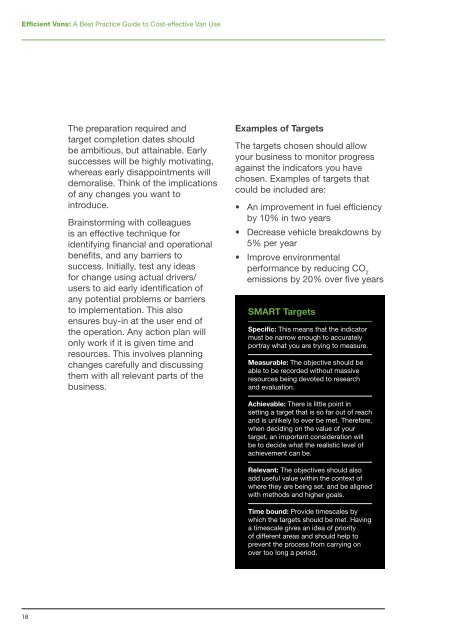Efficient Vans: A Best Practice Guide to Cost - Transport Cafe
Efficient Vans: A Best Practice Guide to Cost - Transport Cafe
Efficient Vans: A Best Practice Guide to Cost - Transport Cafe
You also want an ePaper? Increase the reach of your titles
YUMPU automatically turns print PDFs into web optimized ePapers that Google loves.
<strong>Efficient</strong> <strong>Vans</strong>: A <strong>Best</strong> <strong>Practice</strong> <strong>Guide</strong> <strong>to</strong> <strong>Cost</strong>-effective Van Use<br />
18<br />
The preparation required and<br />
target completion dates should<br />
be ambitious, but attainable. Early<br />
successes will be highly motivating,<br />
whereas early disappointments will<br />
demoralise. Think of the implications<br />
of any changes you want <strong>to</strong><br />
introduce.<br />
Brains<strong>to</strong>rming with colleagues<br />
is an effective technique for<br />
identifying financial and operational<br />
benefits, and any barriers <strong>to</strong><br />
success. Initially, test any ideas<br />
for change using actual drivers/<br />
users <strong>to</strong> aid early identification of<br />
any potential problems or barriers<br />
<strong>to</strong> implementation. This also<br />
ensures buy-in at the user end of<br />
the operation. Any action plan will<br />
only work if it is given time and<br />
resources. This involves planning<br />
changes carefully and discussing<br />
them with all relevant parts of the<br />
business.<br />
Examples of Targets<br />
The targets chosen should allow<br />
your business <strong>to</strong> moni<strong>to</strong>r progress<br />
against the indica<strong>to</strong>rs you have<br />
chosen. Examples of targets that<br />
could be included are:<br />
• An improvement in fuel efficiency<br />
by 10% in two years<br />
• Decrease vehicle breakdowns by<br />
5% per year<br />
• Improve environmental<br />
performance by reducing CO2 emissions by 20% over five years<br />
SMART Targets<br />
Specific: This means that the indica<strong>to</strong>r<br />
must be narrow enough <strong>to</strong> accurately<br />
portray what you are trying <strong>to</strong> measure.<br />
Measurable: The objective should be<br />
able <strong>to</strong> be recorded without massive<br />
resources being devoted <strong>to</strong> research<br />
and evaluation.<br />
Achievable: There is little point in<br />
setting a target that is so far out of reach<br />
and is unlikely <strong>to</strong> ever be met. Therefore,<br />
when deciding on the value of your<br />
target, an important consideration will<br />
be <strong>to</strong> decide what the realistic level of<br />
achievement can be.<br />
Relevant: The objectives should also<br />
add useful value within the context of<br />
where they are being set, and be aligned<br />
with methods and higher goals.<br />
Time bound: Provide timescales by<br />
which the targets should be met. Having<br />
a timescale gives an idea of priority<br />
of different areas and should help <strong>to</strong><br />
prevent the process from carrying on<br />
over <strong>to</strong>o long a period.


